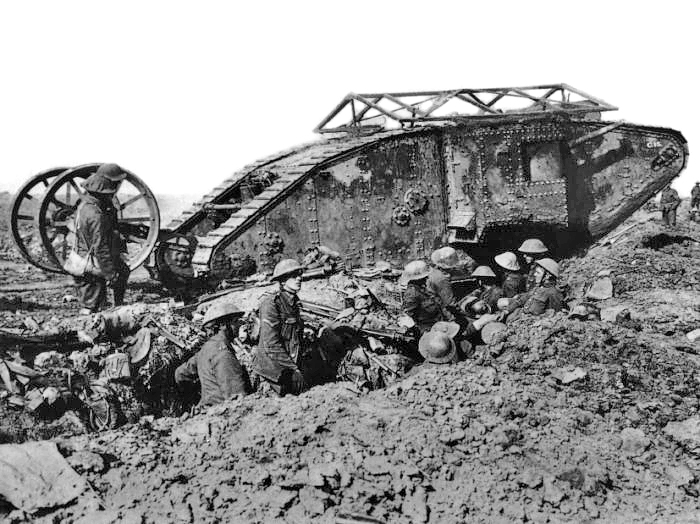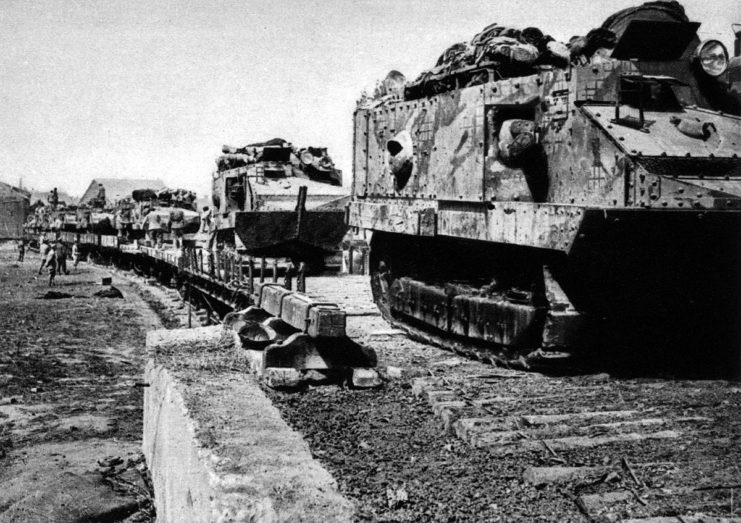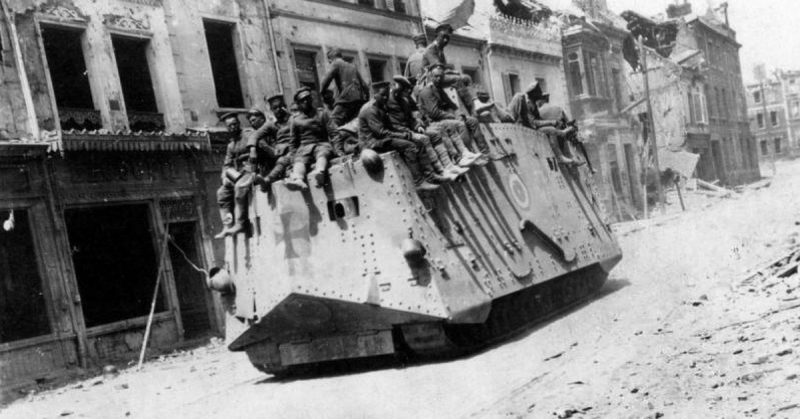During WWI, military designers created the first tanks which changed the face of warfare. Not every nation, however, embraced them with the same level of enthusiasm.
Britain
Tanks in the British army were viewed with eagerness by the government and together with the ingenuity of engineers, resulted in the deployment of heavy tanks.
The man who kicked off the development of the modern tank was Lieutenant Colonel Ernest Swinton. An official eyewitness tasked with recording the events of the war, in 1914 he saw tractors with caterpillar tracks, an American invention, pulling artillery in France. Struck by the use of the technology to get across the difficult ground, he wrote a proposal for an armored fighting vehicle using such tracks. When it was rejected by the British military leadership in France, he sent it to Lieutenant Colonel Maurice Hankey, Secretary of the Committee for Imperial Defence. It was then passed to Winston Churchill, First Lord of the Admiralty.
Churchill, always keen to keep his department at the forefront of military endeavors, had already been looking for a way troops could cross the trenches. Seizing on Swinton’s idea, he set up the Admiralty Landships Committee. With the backing of the Prime Minister, Churchill, Swinton, and others continued their work until a tracked armored fighting vehicle became a reality.
The first working vehicle was created by William Ashbee Tritton and Major Walter Wilson. Tritton was the managing director of Fosters in Lincoln; the company tasked with building a working prototype. Wilson, a military engineer, worked with him in examining examples of American tracked farm vehicles. After repeated problems with the tracks, they applied their engineering experience to create a heavy-duty steel track that ran around the vehicle.
Combined with a powerful engine, ship-style armored plating, and a mixture of guns, it was the first tank.
The first use of the tanks was in September 1916 on the Somme. The massive machines intimidated the Germans and had some success, but the conditions were not right, including no repair facilities and an insufficient number.
The staff of Field Marshal Haig, not a fan of the tanks, tried to have their production canceled. Major Albert Stern, a friend of the Prime Minister and a powerful financier in civilian life, believed in the vehicles. His belief in them once again won political backing.
J. F. C. Fuller secured the future of tanks in the British army. A gifted staff officer, Fuller saw how a solid concentration of tanks, suitably supported, could be a powerful military tool. Under his leadership, tanks won their first significant victory at Cambrai in 1917.
Due to a variety of skilled and keen men, the British were convinced of the value of tanks. The story of their closest allies would be similar, but with a Gallic twist.

France
French tanks evolved in parallel but separately from the British ones.
Central to the story of the French tank was the Schneider company. As agents for the sale of Holt tractors, Schneider sold their wares to the French army for towing guns. Looking to expand their market, in the summer of 1915 they started adding armor and weapons to make a fighting tractor, which they demonstrated in December 1915.
At the same time, Colonel Estienne, having seen Holt tractors towing artillery around, got General Joffre’s support to develop a tractor-based fighting vehicle. When the Renault company proved uninterested, Estienne went to Schneider, learned about their experiments, and teamed up with them. Together, they began work on the first French battle tank – the Schneider CA.
Unfortunately, Estienne had been unwise in his campaign to create the tank. By going directly to Joffre, he had offended the official military automobile service. They decided to develop their own tank and so put him in his place. The resulting Saint Chamond was not a success.
The French became disillusioned with heavy tanks but retained their enthusiasm for the principle of armored fighting vehicles. Instead of the large vehicles favored by the British, they moved toward light, two-man vehicles, resulting in the Renault FT. They wanted to see their vehicles swarm across the battlefield, returning to the bold spirit of attack with which the French had, somewhat disastrously, begun the war. Although they started building tanks later than the British, they soon produced more than their allies.

Germany
During WWII, the German way of fighting was characterized by the swift, decisive, and effective use of tanks. However, in WWI, their attitude was very different.
German troops were shaken by the first appearance of tanks at the Somme. The British had done well at hiding their invention, and it was a fearsome-looking machine to the soldiers encountering it.
The effect of the tanks on that first occasion was underwhelming. They were deployed in unsuitable circumstances and without the use of tactics. Even at Cambrai, the Germans saw the limitation of tanks. General von Walter brought field artillery close to the front, trained his gunners to hit moving targets, and took out 11 British tanks.
As a result, the Germans initially developed a disdain for tanks, believing their value would disappear once the novelty wore off. Instead, the Allies learned to use their tanks effectively, and the Germans began to suffer. Late in the war, they started studying and using captured tanks. They developed their own design and put it into production.
It was too late. Only a handful of German tanks made it into action before the war ended. The power of German tanks would come in the next generation.
Sources:
Taylor Downing (2014), Secret Warriors: Key Scientists, Code Breakers and Propagandists of the Great War
Ian V. Hogg and John Weeks (1980), The Illustrated Encyclopedia of Military Vehicles
William Weir (2006), 50 Weapons that Changed Warfare
Ian Westwell (2008), World War I
